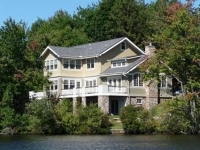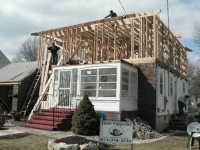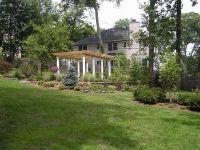Rutgers Study on Number of School-Aged Children Living in Apartments
Runner_Guy said:
FYI... I thought this would be useful analysis for future arguments about development in SOMA.
...https://www.roi-nj.com/2018/07/19/real_estate/rutgers-real-estate-school-releases-landmark-study-on-school-aged-children-in-multifamily-properties/
5. Buildings constructed before 2000 have a significantly higher number of school-age children living in market-rate units than do buildings built after 2000; and
...
So new development has a lower number of school-age children. That could suggest that concern about the number of school-age children may not be a factor when considering new development.
It's not clear if it would be useful to apply the study to local conditions, to draw any conclusion one way or the other. A general study like that can't account for what local conditions may be.
I thought the BOE had indicated what local information (as in, actual number of students in apartments) was showing with respect to this topic (they do have the addresses of students, after all). I think this would be more useful than a general study.
Agree with @nohero. If we don't have an accurate count of how many school aged children are living in apartments, then that kind of throws off future SOMA development(s) and our ability to prepare for incoming future students as these projects expand.
The BOE has a complete number of children attending all schools (think the numbers are available in August) but none are broken down into private homes vs. apartments. Surely they won't do that math and not sure of who would.
nohero said:
Runner_Guy said:So new development has a lower number of school-age children. That could suggest that concern about the number of school-age children may not be a factor when considering new development.
FYI... I thought this would be useful analysis for future arguments about development in SOMA.
...https://www.roi-nj.com/2018/07/19/real_estate/rutgers-real-estate-school-releases-landmark-study-on-school-aged-children-in-multifamily-properties/
5. Buildings constructed before 2000 have a significantly higher number of school-age children living in market-rate units than do buildings built after 2000; and
...
It's not clear if it would be useful to apply the study to local conditions, to draw any conclusion one way or the other. A general study like that can't account for what local conditions may be.
I thought the BOE had indicated what local information (as in, actual number of students in apartments) was showing with respect to this topic (they do have the addresses of students, after all). I think this would be more useful than a general study.
Collum and DeLuca have made claims that the number of students in the new developments are negligible. They based this on a study, not actual data from the district.
I don't think the BOE has ever made any data public regarding location of students.
I've been quoted a few times on the impact of new developments on our schools (even here on MOL). My comments were never in theory, they were grounded in actual numbers. In South Orange, the range of school aged children in TOD projects is 1 for every 30-38 units built. This is relatively close to the assumptions that were made in a Vision Plan from 8 years ago. It's less than the study above (a friend and colleague of mine is one of the authors and I'm presenting with her this Friday on tax abatements).
In the new developments (as an example), I'd estimate that the majority of school-aged children are 1) already in school system and due to personal/family situations - has an apartment address and 2) due the required on-site, inclusionary affordable housing units (which is a good thing from a regional equity perspective and taking on state-wide segregation issues in housing developments).
I'm not at all surprised by the findings in the study - it's been discussed nonstop in the planning/development world but the argument of "the addition of school-aged kids" has always been used as a counter to smart growth and TOD but it's never been based on data.
From a numbers standpoint and given our housing market, someone seeking to rent a 2 or 3 bedroom with school-aged children have the option of purchasing a single-family or two-family residence for the same or lower price point.
The radius and definition of "transit-oriented development" is also a little different with communities that provide shuttle services to and from mass transit - the radius is bigger and doesn't just reflect walkability.
Sheena said:
My comments were never in theory, they were grounded in actual numbers. In South Orange, the range of school aged children in TOD projects is 1 for every 30-38 units built.
So the school district provided hard data to South Orange?
kibbegirl said:
Agree with @nohero. If we don't have an accurate count of how many school aged children are living in apartments, then that kind of throws off future SOMA development(s) and our ability to prepare for incoming future students as these projects expand.
The BOE has a complete number of children attending all schools (think the numbers are available in August) but none are broken down into private homes vs. apartments. Surely they won't do that math and not sure of who would.
The Board of Education would have records on the addresses of school aged children enrolled in South Orange Maplewood School District schools. What they would not have are records indicating the number of home schooled children and the number of children attending private school who live in Maplewood and South Orange. Since a number of demographic factors that can shift over time impact on the number of children attending public school vs private school or home schooling, we would need information beyond school district attendance figures to determine the actual impact on our district from children living in multifamily housing. Location of the multifamily housing building within the community might also be a factor. Do parents of school aged children prefer housing close to a school, park, library, community center?
Sheena said:
I'm not at all surprised by the findings in the study - it's been discussed nonstop in the planning/development world but the argument of "the addition of school-aged kids" has always been used as a counter to smart growth and TOD but it's never been based on data.
From what I've seen on MOL and FB, this issue appears to be one in which no amount of data will persuade people that what their gut is telling them isn't so.
joan_crystal said:
kibbegirl said:The Board of Education would have records on the addresses of school aged children enrolled in South Orange Maplewood School District schools. What they would not have are records indicating the number of home schooled children and the number of children attending private school who live in Maplewood and South Orange. Since a number of demographic factors that can shift over time impact on the number of children attending public school vs private school or home schooling, we would need information beyond school district attendance figures to determine the actual impact on our district from children living in multifamily housing. Location of the multifamily housing building within the community might also be a factor. Do parents of school aged children prefer housing close to a school, park, library, community center?
Agree with @nohero. If we don't have an accurate count of how many school aged children are living in apartments, then that kind of throws off future SOMA development(s) and our ability to prepare for incoming future students as these projects expand.
The BOE has a complete number of children attending all schools (think the numbers are available in August) but none are broken down into private homes vs. apartments. Surely they won't do that math and not sure of who would.
Private school attendance would lower the impact on the district, so if the data is 'all school-age children' it is reflecting the worst case scenario.
Don't private school kids have transportation provided by the district? Probably not all of them use it, but that would provide a clue. Although I agree with ml1 that facts are irrelevant for this issue.
kthnry said:
Don't private school kids have transportation provided by the district? Probably not all of them use it, but that would provide a clue. Although I agree with ml1 that facts are irrelevant for this issue.
I think they get an annual stipend to use against whatever transportation they choose.
ml1 said:
Sheena said:From what I've seen on MOL and FB, this issue appears to be one in which no amount of data will persuade people that what their gut is telling them isn't so.
I'm not at all surprised by the findings in the study - it's been discussed nonstop in the planning/development world but the argument of "the addition of school-aged kids" has always been used as a counter to smart growth and TOD but it's never been based on data.
When I see school-aged children walk out of apartment buildings around town, it's hard to believe theoretical data that says otherwise.
yahooyahoo said:
ml1 said:When I see school-aged children walk out of apartment buildings around town, it's hard to believe theoretical data that says otherwise.
Sheena said:From what I've seen on MOL and FB, this issue appears to be one in which no amount of data will persuade people that what their gut is telling them isn't so.
I'm not at all surprised by the findings in the study - it's been discussed nonstop in the planning/development world but the argument of "the addition of school-aged kids" has always been used as a counter to smart growth and TOD but it's never been based on data.
textbook case of confirmation bias.
Great to see this; Rutgers previously had work from the year ~2000 or so that was increasingly hard to quote as it aged.
Here in West Orange last year, we had a demographer do a 5-year look-ahead for the district, and part of that (the ~10 pages beginning at page 68) looked at student yields by dwelling type (single family vs. townhouse/condo vs apartment), not just town-wide, but also by elementary school zone. We'll see as time goes on how accurate it turns out to be. (It looks like SOMa did a similar study at around the same time, but (at least in this report) without the specific focus on student yields.)
yahooyahoo said:
ml1 said:When I see school-aged children walk out of apartment buildings around town, it's hard to believe theoretical data that says otherwise.
Sheena said:From what I've seen on MOL and FB, this issue appears to be one in which no amount of data will persuade people that what their gut is telling them isn't so.
I'm not at all surprised by the findings in the study - it's been discussed nonstop in the planning/development world but the argument of "the addition of school-aged kids" has always been used as a counter to smart growth and TOD but it's never been based on data.
How do you know those "apartment buildings" are not condos? We have a lot of condos/townhouses in these towns that "look" like apartments.
ml1 said:
yahooyahoo said:textbook case of confirmation bias.
ml1 said:When I see school-aged children walk out of apartment buildings around town, it's hard to believe theoretical data that says otherwise.
Sheena said:From what I've seen on MOL and FB, this issue appears to be one in which no amount of data will persuade people that what their gut is telling them isn't so.
I'm not at all surprised by the findings in the study - it's been discussed nonstop in the planning/development world but the argument of "the addition of school-aged kids" has always been used as a counter to smart growth and TOD but it's never been based on data.
Let's talk about confirmation bias.
Two of the four people that collaborated on the Rutgers' white paper represent real estate development companies:
Collaborating on the paper were executive committee members Debra Tantleff, founder and president of Tantum Real Estate; Ron Ladell, senior vice president of AvalonBay Communities; and professor David Frame, director of curriculum for the Rutgers Center for Real Estate.
The lead professor is Morris Davis, the Paul V. Profeta Chair of Real Estate and academic director of the Rutgers Center for Real Estate.
It's clear that real estate developers would prefer the data show that student populations in multi-family units are relatively low, which would mitigate community opposition to these type of developments.
There is nothing that states the paper was peer-reviewed either.
max_weisenfeld said:
joan_crystal said:Private school attendance would lower the impact on the district, so if the data is 'all school-age children' it is reflecting the worst case scenario.
kibbegirl said:The Board of Education would have records on the addresses of school aged children enrolled in South Orange Maplewood School District schools. What they would not have are records indicating the number of home schooled children and the number of children attending private school who live in Maplewood and South Orange. Since a number of demographic factors that can shift over time impact on the number of children attending public school vs private school or home schooling, we would need information beyond school district attendance figures to determine the actual impact on our district from children living in multifamily housing. Location of the multifamily housing building within the community might also be a factor. Do parents of school aged children prefer housing close to a school, park, library, community center?
Agree with @nohero. If we don't have an accurate count of how many school aged children are living in apartments, then that kind of throws off future SOMA development(s) and our ability to prepare for incoming future students as these projects expand.
The BOE has a complete number of children attending all schools (think the numbers are available in August) but none are broken down into private homes vs. apartments. Surely they won't do that math and not sure of who would.
Exactly. My point is that if we were to base our analysis solely on school district attendance data, we would be under reporting the number of children living in Maplewood and South Orange. Since some of these children fluctuate between private and public school attendance during their school-aged years, we would not be seeing the full impact on the school district over time.
http://njplanning.org/wp-content/uploads/Redevelopment-and-Tax-Abatement-Workshop.pdf
The workshop that Sheena mentioned in her post.
yahooyahoo said:
ml1 said:Let's talk about confirmation bias.
yahooyahoo said:textbook case of confirmation bias.
ml1 said:When I see school-aged children walk out of apartment buildings around town, it's hard to believe theoretical data that says otherwise.
Sheena said:From what I've seen on MOL and FB, this issue appears to be one in which no amount of data will persuade people that what their gut is telling them isn't so.
I'm not at all surprised by the findings in the study - it's been discussed nonstop in the planning/development world but the argument of "the addition of school-aged kids" has always been used as a counter to smart growth and TOD but it's never been based on data.
Two of the four people that collaborated on the Rutgers' white paper represent real estate development companies:
Collaborating on the paper were executive committee members Debra Tantleff, founder and president of Tantum Real Estate; Ron Ladell, senior vice president of AvalonBay Communities; and professor David Frame, director of curriculum for the Rutgers Center for Real Estate.
The lead professor is Morris Davis, the Paul V. Profeta Chair of Real Estate and academic director of the Rutgers Center for Real Estate.
It's clear that real estate developers would prefer the data show that student populations in multi-family units are relatively low, which would mitigate community opposition to these type of developments.
There is nothing that states the paper was peer-reviewed either.
I was referring to the fact that Sheena Collum said she was reporting real numbers for students in SOMA.
In 2015 when I was on the BOE I got the numbers for how many public school students lived in various TOD and high-end apartment buildings in town and wrote an op-ed about it.
There's variation in how many kids live in apartments that I think depends on square footage and not just bedrooms (hence The Avenue has a non-trivial number of kids), but overall, most of SOMA's apartments have fewer kids than would fit in a minivan and one I found even had zero.
Of the unPILOTed buildings I got data for, 10 Ridgewood Road, the Top, Renaissance Place, Village Station East, Village Station West, the Mews, 171 Vose Avenue, the Concord (177 Irvington Ave), the Station House, Village Court, 321 Wyoming Avenue, 14 Highland Place, and the Newstead had a total of only 43 public school children living there (counting students placed out-of-district).
The Top, in particular, has a minuscule number of kids relative to how many apartments it has and what taxes it pays, which seems to corroborate the finding in the Rutgers study that highrises have even fewer kids than low-rises and mid-rises.
Based on the Top and the Rutgers study, from a tax and budget POV, I think high-rise development would be extremely beneficial for us.
https://villagegreennj.com/schools-kids/bennett-new-development-without-pilots-benefits-schools/
I think that SOMA's ratio of students per unit might be lower than the averages reported in this Rutgers study, even if you account for the fact that the Rutgers study didn't factor out private school & home school kids.
Runner_Guy said:
“Based on the Top and the Rutgers study, from a tax and budget POV, I think high-rise development would be extremely beneficial for us.“
While that may be true, from a traffic impact POV, it would further exacerbate a problem that gets worse in town seemingly every day.
Running_Guy, thanks for summarizing your work so well...I was starting to explain it, but accidentally threw out my work. Many of these developments are full of a combination of young commuters not ready to own a home, downsized retirees, and a smattering of divorced parents staying near the family home. Children coming out of the building may be visiting a grandparent or a parent, rather than being full time residents.
I'd also note, anecdotally, that I've followed this carefully for years, due to the fear-mongering we sometimes hear about development. My MIL has lived in Gaslight Commons, followed by The Newstead, for most of decade, and can verify that almost no school age children live in either. I've scanned South Mountain Elementary School directories a few times and seen the same. I think my children knew one child who lived in Gaslight Commons during kindergarten, while parents committed to the area searched for the perfect house. They also went to one playdate in The Newstead, with a child in a split-custody arrangement, whose father had purchased a condo near the former family home.
Finally, I'm glad to see a new Rutgers report, so there is fresher data. The authorship does mean that I read the methodology carefully, and look for slanted interpretation, but the data is there. It shows that being near a transit hub and having good schools both seem to depress the number of children per unit, in ways that are consistent with the detailed picture that Running_Guy assembled.
When Orange Lawn development was being discussed, the old report (which also looked at single family homes) showed that building 8 single family homes would likely have a bigger impact on the school system than the few dozen condos then under consideration (which would probably have been snapped up by downsizing seniors!).
erins said:How do you know those "apartment buildings" are not condos? We have a lot of condos/townhouses in these towns that "look" like apartments.
When I see school-aged children walk out of apartment buildings around town, it's hard to believe theoretical data that says otherwise.
"Apartments" and "condos" are not mutually exclusive. A condominium is simply a form of ownership. An apartment, townhouse, duplex (or semi-attached house, as we call it in NYC), and single detached house are a forms of housing—irrespective of their form of ownership. Any of them can be condos. So "looking like" an apartment doesn't mean anything. It's an apartment. It may also be owned as a condo unit. Or it may be a rental unit.
shoshannah said:
erins said:"Apartments" and "condos" are not mutually exclusive. A condominium is simply a form of ownership. An apartment, townhouse, duplex (or semi-attached house, as we call it in NYC), and single detached house are a forms of housing—irrespective of their form of ownership. Any of them can be condos. So "looking like" an apartment doesn't mean anything. It's an apartment. It may also be owned as a condo unit. Or it may be a rental unit.How do you know those "apartment buildings" are not condos? We have a lot of condos/townhouses in these towns that "look" like apartments.
When I see school-aged children walk out of apartment buildings around town, it's hard to believe theoretical data that says otherwise.
Yes - I live in a condo and many people have asked if my complex is a condo or rental. Hence, why you can't go by what a structure looks likes. There is a 6-7 story building across from CHS that "looks" like an apartment, but is a condo building.
Frankly, I don't get the obsession with counting kids in apartments. What about the families that live in rental homes - are they not a concern as well?
susan1014 said:
Running_Guy, thanks for summarizing your work so well...I was starting to explain it, but accidentally threw out my work. Many of these developments are full of a combination of young commuters not ready to own a home, downsized retirees, and a smattering of divorced parents staying near the family home. Children coming out of the building may be visiting a grandparent or a parent, rather than being full time residents.
I'd also note, anecdotally, that I've followed this carefully for years, due to the fear-mongering we sometimes hear about development. My MIL has lived in Gaslight Commons, followed by The Newstead, for most of decade, and can verify that almost no school age children live in either. I've scanned South Mountain Elementary School directories a few times and seen the same. I think my children knew one child who lived in Gaslight Commons during kindergarten, while parents committed to the area searched for the perfect house. They also went to one playdate in The Newstead, with a child in a split-custody arrangement, whose father had purchased a condo near the former family home.
Finally, I'm glad to see a new Rutgers report, so there is fresher data. The authorship does mean that I read the methodology carefully, and look for slanted interpretation, but the data is there. It shows that being near a transit hub and having good schools both seem to depress the number of children per unit, in ways that are consistent with the detailed picture that Running_Guy assembled.
When Orange Lawn development was being discussed, the old report (which also looked at single family homes) showed that building 8 single family homes would likely have a bigger impact on the school system than the few dozen condos then under consideration (which would probably have been snapped up by downsizing seniors!).
The Village Coffee building which consists of 8 apts, houses one school age child.
@yahooyahoo - to answer your earlier question, yes. At the time I did the first calculations (similar to Runner_Guy), the numbers were very low (roughly mid-2016 was the last time). The district, not surprisingly, would prefer not to give the exact counts for each development due to privacy concerns. However, members of the governing body having these conversations with the district know what they are.
I know it's easy to dismiss what developers say (I do it all the time in negotiations) but in this instance, I do believe their data is correct and follows trends throughout NJ where developers, the planners I work with, and smart growth advocates would agree.
To the larger question of the influx of children in the district - it's the turnover of single family homes from individuals/families without school-aged children to those with school-aged children and there's not one factor that contributes to this (although, it is primarily taxes). We initiated "SOMA Two Towns for All Ages" in 2016 through a grant to focusing on attracting and retaining senior citizens to our community. For the grant, we partnered with Maplewood and have received funding for the second year. While there are components such as transportation and social inclusion/opportunities, our primary issue is housing and how to keep people in their homes. Both South Orange and Maplewood are working on home-sharing options as one opportunity but the reality is it's so tough to control the market and the choices people make.
I'm sorry for the tangent but I really do enjoy this topic because we deal with it every day in discussions about taxes, schools, infrastructure, etc. So I'll continue a little more.
Residents have also chosen to downsize into apartments but in some instances, it's not the amount that's driving that decision, it's preference (maintenance free, no stairs, etc.). Where our biggest housing deficiency, in my opinion and certainly supported by our local real estate community, are mid-range condos. There's a market but limited supply. I'm actively working on that in some of our upcoming projects. Broadly speaking, the financing supports rentals over condos (it's a long story).
Back to @yahooyahoo - thank you for sharing the event I'm hosting. While we'll be discussing a lot about tax abatements, the workshop will also address many misconceptions about redevelopment. While impact on schools is generally one, the others include but are not limited to: parking ratios in TOD communities and trip generation, the cost of providing inclusionary affordable housing (which is primarily what these aggressive PILOTs support), land acquisition fees, how we control PILOts through "excess profit" provisions, etc. Some people use to term "developer giveaways", I get it - it's a great political soundbite. However, the reality is we scrub pro-formas and project costs until they bleed (at least in South Orange we do). This is thousands of cells of projected incomes, operating expenses, soft and hard costs, the NPV of annual services charges versus remaining undeveloped, what the various yields are at different points in the projects and when they're refinanced, etc.
I think that's all in my mind for now or I'll hit the MOL word count ;-)
Thank you Sheena. I appreciate your engagement with our online debate.
To build on Sheena's comment regarding SOMA Two Towns For All Ages: Maplewood and South Orange have had an elder flight problem for many years and -yes- that problem has contributed to the expansion of students in the school system, which in turn has contributed to higher school costs, which has contributed to higher real property taxes in both towns, which has contributed to making it too expensive for some empty nesters to remain in their home.
While unaffordable cost of living is one of the most frequently mentioned reasons seniors give for selling their house and moving from the area, there are other factors that also contribute to elder flight. These include declining physical ability to perform interior and exterior home maintenance, inability to navigate interior and exterior stairs safely, declining health requiring moving to a warmer climate, social isolation, lack of transportation options when one can no longer drive, insufficient provision for the elderly at local events, and desire to move closer to one's children/grandchildren. SOMA Two Towns For All Ages is working to address all of these needs.
Sheena mentions insufficient housing in our community for seniors looking to downsize and/or find single level housing. There is definitely a need for multifamily housing designed specifically for seniors; however, such housing availability would work to encourage seniors to move to such housing rather than find ways to stay in their home. A less recognized contributor to senior flight is lack of affordable starter housing for young adult children newly out of school who do not want to continue living in their parent's home. We need to find hosing alternatives to keep our children in the community. This in turn will help to establish the support system that in turn will help our empty nesters remain in their homes for a longer period of time.
joan_crystal said:
Sheena mentions insufficient housing in our community for seniors looking to downsize and/or find single level housing. There is definitely a need for multifamily housing designed specifically for seniors; however, such housing availability would work to encourage seniors to move to such housing rather than find ways to stay in their home. A less recognized contributor to senior flight is lack of affordable starter housing for young adult children newly out of school who do not want to continue living in their parent's home. We need to find housing alternatives to keep our children in the community. This in turn will help to establish the support system that in turn will help our empty nesters remain in their homes for a longer period of time.
I actually think the solution for SOMA and society generally is to allow more apartment development, including high-rises.
If you look at Portland and Seattle, rents are actually falling despite red-hot economies, because they have allowed so many apartments to be built.
Allowing more high-density development, including high rises, is also a solution to SOMA's 3% tax rate, since apartments here tend to have so few children living in them, and high-rises have even fewer school-aged children than mid-rises and low-rise rentals.
I know that the drawback of allowing high-rises is increased traffic, but to me the tradeoff is worth it.
For Sale
Sponsored Business
Promote your business here - Businesses get highlighted throughout the site and you can add a deal.



























FYI... I thought this would be useful analysis for future arguments about development in SOMA.
https://www.roi-nj.com/2018/07/19/real_estate/rutgers-real-estate-school-releases-landmark-study-on-school-aged-children-in-multifamily-properties/